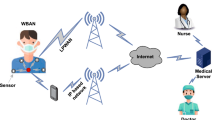Abstract
The wireless body area network (WBAN) has emerged as a new technology for e-healthcare that allows real time monitoring of patients using miniaturized wearable and implantable sensors. An important concern in such networks is the secure transmission, without burdening the energy requirements. In this paper, a new energy efficient protocol is presented with enhanced inherent security, interference rejection and patient/node identification. The energy usage is low as there is no additional encryption circuitry required. Moreover, the nodes can sleep in the slots when they are not transmitting or receiving. The protocol implementation is experimentally demonstrated using low cost IR transceiver and Arduino Microcontroller. Experimental results reveal the successful transmission and reception of measured parameters over short ranges with sufficient accuracy. Furthermore, a MATLAB based mobile application is developed which helps to set up a database in distributed manner and subsequently allow the user to monitor, visualize and share the measured readings remotely.









Similar content being viewed by others
References
Kaur, R. (2011). Wireless body area network and ITS. An International Journal of Engineering Sciences, 1, 199–216.
Saha, M. S., & Anvekar, D. D. K. (2014). State of the art in WBAN security and open research issues. International Journal on Recent and Innovation Trends in Computing and Communication, 2(7), 1958–1964.
O’Brien, D. C., Katz, M., Wang, P., Kalliojarvi, K., Arnon, S., Matsumoto, M., Green, R. J., & Jivkova, S. (2005). Short-range optical wireless communications. Wireless world research forum, 1-22.
Elgala, H., et al. (2011). Indoor optical wireless communication: Potential and state-of-the-art. IEEE Communications Magazine, 49(9), 56–62.
Wolf, M., & Kreb, D. (2003). Short range wireless infrared transmission: The link budget compared to RF. IEEE Wireless Communications, 10(2), 8–14.
Dickensonz, R. J., & Ghassemlooy, Z. (2005). Wavelet–AI equalization and detection for indoor diffuse infrared wireless systems. International Journal of Communication System, 18, 247–266.
Khan, J. M., & Barry, J. R. (1997). Wireless infrared communication. Proceedings of the IEEE, 85(2), 265–298. doi:10.1109/5.554222.
Singh, C., et al. (2002). A review on indoor optical wireless systems. IETE Technical Review, 19(1 a and 2), 3–17.
Arya, A., & Bilandi, N. (2014). A review: Wireless body area networks for health care. International Journal of Innovative Research in Computer, 2(4), 3800–3806.
He & Daojing. (2014). Lightweight and confidential data discovery and dissemination for wireless body area networks. IEEE Journal of Biomedical and Health Informatics, 18(2), 440–448.
Crosby, G. V., et al. (2012). Wireless body area networks for healthcare: A survey. International Journal of Ad hoc, Sensor and Ubiquitous Computing (IJASUC), 3(3), 1–26.
Kwak, M. A., et al. (2012). Security and privacy issues in wireless sensor networks for healthcare applications. Journal of Medical Systems, 36(1), 93–101.
Ullah, S., Imran, M., & Alnuem, M. (2014). A Hybrid and Secure Priority-Guaranteed MAC Protocol forWireless Body Area Network. International Journal of Distributed Sensor Networks, 10(2), 481761. doi:10.1155/2014/481761.
Dimitriou, T., & Ioannis, K. (2008). Security issues in biomedical wireless sensor networks. Denmark: First International Symposium on Applied Sciences on Biomedical and Communication Technologies. Aalborg University.
Ramli, S. N., & Ahmad, R. (2011). Surveying the wireless body area network in the realm of wireless communication. In 7th International Conference on Information Assurance and Security, Melaka.
AL-Rassan, I. A., & Khan, N. (2011). Secure and energy efficient key management scheme for WBAN—A hybrid approach. International Journal of Computer Science and Network Security, 11(6), 169–172.
Qadri, S. F. et al. (2013). Applications, challenges, security of wireless bodyarea networks (WBANS) and functionality of IEEE 802.15.4/ZIGBEE. Sci. Int, Lahore.
Kanjee, et al. (2013). A generic authentication protocol for wireless body area networks. BODYNETS 2013, Boston, United States.
Barakah, D. M., & Ammad-uddin M. (2012). A survey of challenges and applications of wireless body area network (WBAN) and role of a virtual doctor server in existing architecture. In Third International Conference on Intelligent Systems Modelling and Simulation.
Kumar, R., & Mukesh, R. (2013). State of the art: Security in wireless body area networks. International Journal of Computer Science and Engineering Technology (IJCSET), 4(5), 622–630.
Davies, E., Sanjay, K., & Mohana, J. (2014). A survey on wireless body area network 1. 4(3), 1–7. Retrieved from http://www.ijsrp.org/research-paper-0314/ijsrp-p2752.pdf.
Javali, C. et al. (2014). SeAK: Secure authentication and key generation protocol based on dual antennas for wireless body area networks. In 10th International Workshop, RFIDSec, Oxford UK, Springer, (pp. 74–89).
Wu, X. (2014). A lightweight trust-based access control model in cloud-assisted wireless body area networks. International Journal of Security and Its Applications, 8(5), 131–138.
Mana, M. (2009). Secure and efficient key exchange for wireless body area network. International Journal of Advanced Science and Technology, 12, 45–60.
Saleem, S. (2011). A Study of IEEE 802.15.4 security framework for wireless body area networks. Sensors Journal, 11(2), 1383–1395.
SB-Projects: IR remote control, Sony SIRC Protocol, http://www.sbprojects.com/knowledge/ir/sirc.php. Accessed on 22 December 2014.
www.cooking-hacks.com. Accessed on 22 December 2014.
www.mathworks.com/mobile/. Accessed on 22 December 2014.
Baqai, A., et al. (2014). Design, development and implementation of the IR signalling techniques for monitoring ambient and body temperature in WBANs. MUET Research Journal of Engineering and Technology (MURJ), 33(3), 365–371.
Acknowledgements
This project was carried out in Institute of Information and Communication Technologies (IICT), Mehran university of Engineering and Technology Pakistan under endowment scheme. The authors are Grateful to the Department of Electronics, Directorate of IICT and Planning and Development Section of MUET for the technical and financial support respectively.
Author information
Authors and Affiliations
Corresponding author
Rights and permissions
About this article
Cite this article
Baqai, A., Umrani, F.A. & Chowdhry, B.S. A Novel Protocol with Patient and Node Identification for Optical WBAN with Inherent Security and Interference Rejection. Wireless Pers Commun 95, 4211–4224 (2017). https://doi.org/10.1007/s11277-017-4075-9
Published:
Issue Date:
DOI: https://doi.org/10.1007/s11277-017-4075-9




